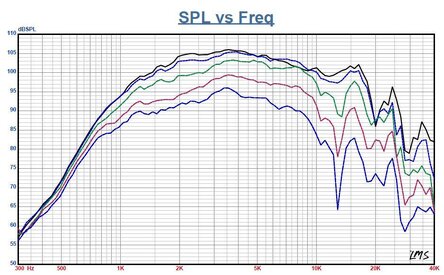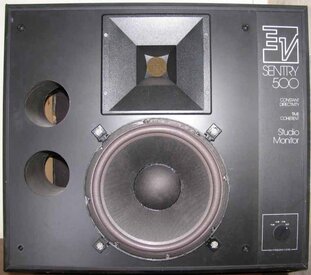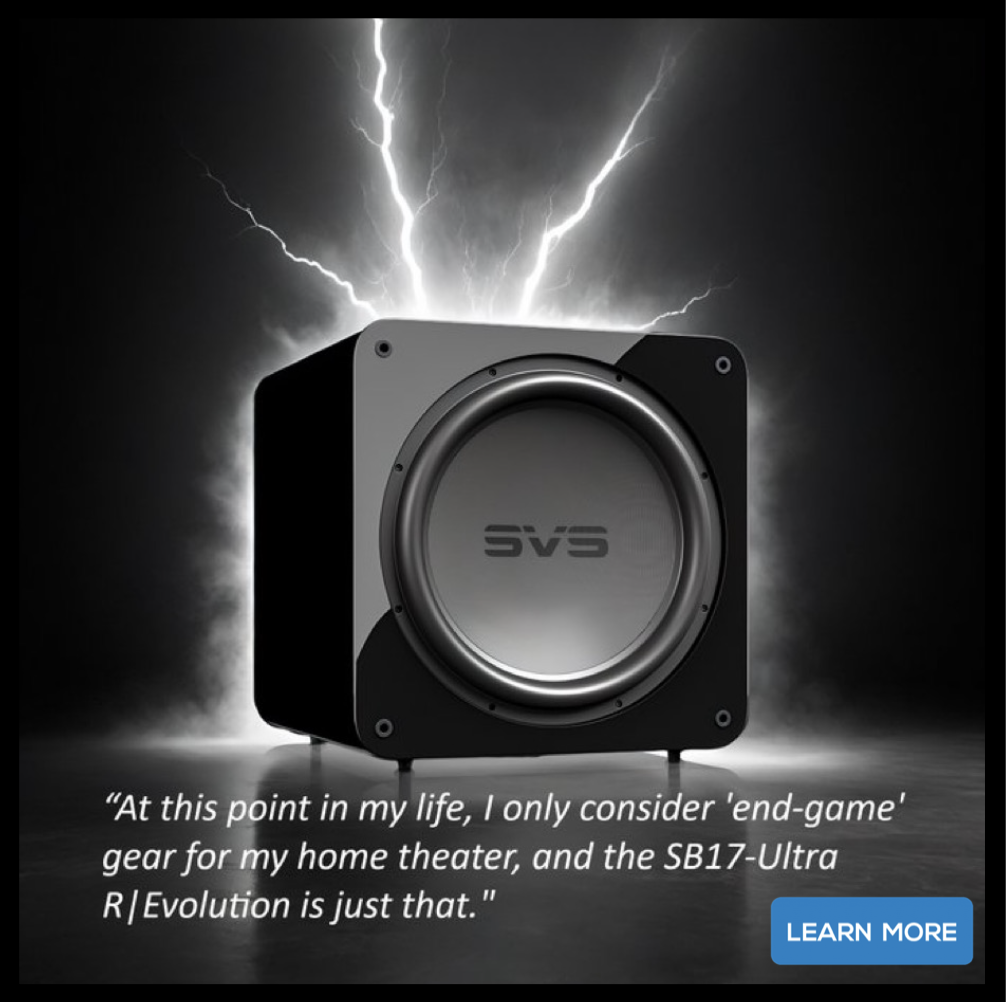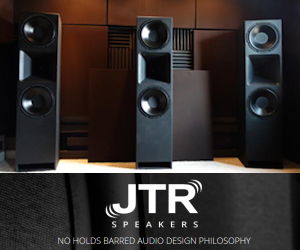Matthew J Poes
AV Addict
Thread Starter
- Joined
- Oct 18, 2017
- Posts
- 1,904
as a way to break off our discussion around tweeters, I am creating this thread.
As I noted before, I had some bad experiences with the folded air motion tweeters and walked away unconvinced it was anything special. I don't feel that Domes are for the proletariat. Instead I generally feel that tweeters are a commodity and that there are good and bad of all. That the final product is what matters, with equally good results being possible from all technologies.
Which isn’t to say that certain tweeters don’t have advantages.
My own speakers use compression drivers. Their advantage are that they optimally mate to a waveguide minimizing diffraction and reflections in the mouth, produce a phase coherent spherical wavefront, and are very high power and sensitive. There negative is that they require a special phase plug to create that wavefront and it necessarily puts a limitation on the upper end of the response, as does the dome or ring radiator, which is often much larger than other tweeters. As such, few produce out to 20khz and beyond. Arguably not audible, but a limitation.
Ribbons are cool, the light diaphragm allows for reproduction of highs to very high frequencies. They have low distortion when operated within their linear range. When designed right they have very wide horizontal dispersion but well controlled vertical dispersion. Their cons are that they can’t reproduce lower treble without being very large. Additionally, they need an expensive transformer which can impact sound quality. Finally, they don’t handle much power and are known to be easy to blow. I’m reviewing a speaker with a true ribbon and the designer conceded I need to be careful.
Dome tweeters are probably the most ubiquitous tweeter type. They are great! Designed right they can have a very wide bandwidth, good dispersion, and low distortion. Additionally, few tweeter types have a smoother response than the humble dome. Material type can matter, but I’m not convinced a particular material matters as much as it’s implementation. The new Beryllium dome tweeters from Scan Speak, Seas, and Satori are all amazing standout performers. I’ve also recently fallen in love with speakers that use Berrylium. I've heard some argue that titanium and aluminum, silk, ceramic, etc. can all achieve equally good results. Their negative, they don’t have well controlled dispersion and tend to beam at high frequencies. As such the directivity changes at some point, usually around 10khz. This can lead to the speaker sounding a bit dull or lacking extension in room if too severe. They also don't handle a lot of power usually. They didn't used to be very sensitive but that has changed.
Planar: well this approach allows for a large surface area that can control dispersion well. They operate by virtue of a printed or adhered voice coil on a light film diaphragm placed within a magentic field. Like ribbons they tend to have unusually low distortion and an ability to extend to really high frequencies. Their negative is that they often don’t have the flattest response. You either accept a lot of garbage or use them over a specified bandwidth. Not all are created equal either. B&G makes some pretty good ones. These tend to distort when you get too low in frequency in a more abnoxious way and have not always been the most reliable. I rebuilt close to 100 classic Infinity Emit tweeters in my day, I’m only 37!
Air Motion transformer: this approach is said to allow a large radiating surface area and often they can extend very high in frequency. They are a lot like a Planar in operation, but instead of the enter diaphragm moving in and out, it compresses and expands like an accordion. They can be built to shape the wavefront so at least over a given distance they aren’t spherical, and can be built to be both efficient and robust. But like I said, they are still a commodity product. There are good and bad versions of all these designs. And...there seem to be a lot of bad Airmotions on the market.
So I don’t dislike airmotions because they are inherently bad. It’s because I have seen a lot of bad ones and it seems like good ones are quite expensive. I know RBH feels the same way and had to use a very expensive air motion tweeter to get one that met their expectations. And it’s my understanding that they use it instead of beryllium domes because it’s almost as good for a lot less money, rather than better.
My view remains that it is possible to achieve good results with any tweeter design. The design is less important than how it performs and how the designer implements it.
Now let’s look at some Voicecoil test bench measurements for examples of good versions of all designs:
Let’s start with a Satori Beryllium dome

And distortion

Not bad. There are some problems up high, but very high Q and likely not audible.
How about a ribbon (Tnagband)


Look at that dispersion and extension. Doesn’t get much better than that (if your goal is wide dispersion). Distortion is not bad, but you can see that it must be used with a high crossover. This ribbon is small, but then, it’s still much larger than a 1” dome tweeter that itself could operate far Lower.
How about a good CD (18 sound 1.4” model, HF garbage is largely dictated by the horn or waveguide and may look different on a better one):


As you can see it has a good flat response with very good directivity control. Better than any other design so far. It’s distortion is silly low. More amazing, look carefully at the drive level. Pro drivers are tested at far higher levels than consumer drivers. This tweeter can play far louder than any consumer tweeter can dream of with no distortion. Obviously the really Hf stuff is a little messier than the ribbon, but again, this is completely waveguide dependent. Even the measuring distance matters here. It’s caused by reflections in the waveguide. Other designs don’t have this problem and it’s not as audible a problem as it looks.
How about a Beyma Air Motion:

It’s not terrible, but i think the others look better. Most of its worst problems are near or above 20khz. It does beam quite a bit worse than the others.


Here is the waveguide loaded version. For this one, I honestly don’t see the point. The response doesn’t look good. I don’t see a great advantage to this driver. It has a bad diffraction artifact at 15khz and doesn’t have the best directivity control. It is possible that with the right crossover it would achieve good results. It’s very likely that bad stuff at 15khz isn’t audible.
Distortion isn’t as bad as it looks. Look at the scale, it’s mostly under 1%. It’s also not better than other designs however.
So what else could be it’s advantage? Well a common view is that they are simply a more deft tweeter that store less energy and sound cleaner. Maybe? We saw the distortion was no better and response worse than other deistns (but again it’s totally a workable response). So let’s look at CSD:

So that is pretty good actually. It stores very little energy. It’s on and off like a switch. Just a bit of stored energy at maybe like 3khz and very low in levels. So this could be a legit Claim.
Here is another Airmotion CSD:

Again looks good. Not as good, but very good.
Here is a B&C compression driver, not as good but still good. Stores energy at 1-2khz. I believe that this may be somewhat waveguide dependent because it seems they are all over the place.

Here is that 18 sound which has a big 1.4” opening and 3” diaphragm. It also had a huge waveguide so I suspect this energy storage is characteristic of such a big system.

Pretty good all things considered but clearly sorting more energy than the others.
Here is that Satori Dome tweeter

A bit more energy initially but absolutely no ringing. It’s good.
One last thing to make my point:
Look at this set of measurements.



I think that looks really good. It does some things better and some things worse than other designs. As a whole I see nothing there to tell me it’s a lesser tweeter. That is a relatively cheap Wavecor silk dome tweeter. It even extends well past 20khz!
Now what was my own issue with the airmotion? Without naming names, I had some sent to me as samples to test. I won’t get into how or why, but needless to say, they ranged in price and quality but all came from the same Chinese manufacturer (who actually makes most of the Chinese built AMT’s for most companies).
One of them had poor QC and the pair I received measured differently. It had a buzz and distortion in one of the devices from bad riveting.
All displayed comb filtering but it seemed to dissipate with distance. I think the front plate causes it.
The large ones could be crossed low, below 2khz, but they were as big as a good waveguide that could cross a full octave lower. And they couldn’t extend smoothly past 10khz. They had a very irregular response. I figured it might work better as an upper midrange or lower treble driver. But then, what are making, 5-way speakers?
The medium sized ones were ok. Could cross around 2.5khz and had a workable response to my upper measurement limit of the time. They had high distortion if driven hard. Like they became non-linear quick. I found you would need to use high order crossovers or cross much higher to avoid the problem.
I ended up killing two of them in testing. I’ve never killed a tweeter in testing other than a ribbon once.
So I was left feeling like the AMT was fine but nothing special. That other drivers might offer advantages i prefer. I think because they are so hot I’m more sour on them given this experience. If it was treated like what I think it is, just another means to an end, I probably would be more forgiving.
As I noted before, I had some bad experiences with the folded air motion tweeters and walked away unconvinced it was anything special. I don't feel that Domes are for the proletariat. Instead I generally feel that tweeters are a commodity and that there are good and bad of all. That the final product is what matters, with equally good results being possible from all technologies.
Which isn’t to say that certain tweeters don’t have advantages.
My own speakers use compression drivers. Their advantage are that they optimally mate to a waveguide minimizing diffraction and reflections in the mouth, produce a phase coherent spherical wavefront, and are very high power and sensitive. There negative is that they require a special phase plug to create that wavefront and it necessarily puts a limitation on the upper end of the response, as does the dome or ring radiator, which is often much larger than other tweeters. As such, few produce out to 20khz and beyond. Arguably not audible, but a limitation.
Ribbons are cool, the light diaphragm allows for reproduction of highs to very high frequencies. They have low distortion when operated within their linear range. When designed right they have very wide horizontal dispersion but well controlled vertical dispersion. Their cons are that they can’t reproduce lower treble without being very large. Additionally, they need an expensive transformer which can impact sound quality. Finally, they don’t handle much power and are known to be easy to blow. I’m reviewing a speaker with a true ribbon and the designer conceded I need to be careful.
Dome tweeters are probably the most ubiquitous tweeter type. They are great! Designed right they can have a very wide bandwidth, good dispersion, and low distortion. Additionally, few tweeter types have a smoother response than the humble dome. Material type can matter, but I’m not convinced a particular material matters as much as it’s implementation. The new Beryllium dome tweeters from Scan Speak, Seas, and Satori are all amazing standout performers. I’ve also recently fallen in love with speakers that use Berrylium. I've heard some argue that titanium and aluminum, silk, ceramic, etc. can all achieve equally good results. Their negative, they don’t have well controlled dispersion and tend to beam at high frequencies. As such the directivity changes at some point, usually around 10khz. This can lead to the speaker sounding a bit dull or lacking extension in room if too severe. They also don't handle a lot of power usually. They didn't used to be very sensitive but that has changed.
Planar: well this approach allows for a large surface area that can control dispersion well. They operate by virtue of a printed or adhered voice coil on a light film diaphragm placed within a magentic field. Like ribbons they tend to have unusually low distortion and an ability to extend to really high frequencies. Their negative is that they often don’t have the flattest response. You either accept a lot of garbage or use them over a specified bandwidth. Not all are created equal either. B&G makes some pretty good ones. These tend to distort when you get too low in frequency in a more abnoxious way and have not always been the most reliable. I rebuilt close to 100 classic Infinity Emit tweeters in my day, I’m only 37!
Air Motion transformer: this approach is said to allow a large radiating surface area and often they can extend very high in frequency. They are a lot like a Planar in operation, but instead of the enter diaphragm moving in and out, it compresses and expands like an accordion. They can be built to shape the wavefront so at least over a given distance they aren’t spherical, and can be built to be both efficient and robust. But like I said, they are still a commodity product. There are good and bad versions of all these designs. And...there seem to be a lot of bad Airmotions on the market.
So I don’t dislike airmotions because they are inherently bad. It’s because I have seen a lot of bad ones and it seems like good ones are quite expensive. I know RBH feels the same way and had to use a very expensive air motion tweeter to get one that met their expectations. And it’s my understanding that they use it instead of beryllium domes because it’s almost as good for a lot less money, rather than better.
My view remains that it is possible to achieve good results with any tweeter design. The design is less important than how it performs and how the designer implements it.
Now let’s look at some Voicecoil test bench measurements for examples of good versions of all designs:
Let’s start with a Satori Beryllium dome
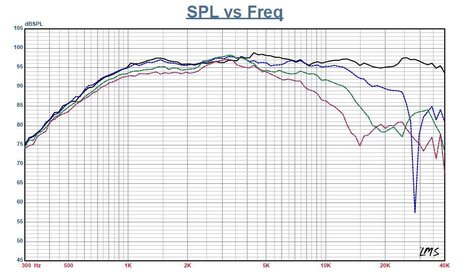
And distortion
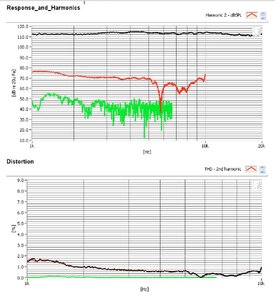
Not bad. There are some problems up high, but very high Q and likely not audible.
How about a ribbon (Tnagband)
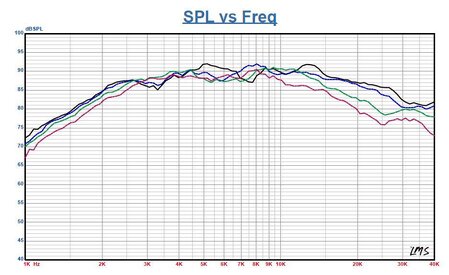
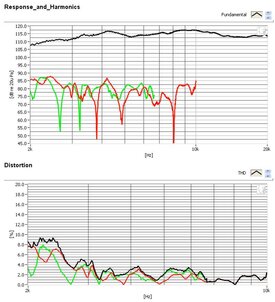
Look at that dispersion and extension. Doesn’t get much better than that (if your goal is wide dispersion). Distortion is not bad, but you can see that it must be used with a high crossover. This ribbon is small, but then, it’s still much larger than a 1” dome tweeter that itself could operate far Lower.
How about a good CD (18 sound 1.4” model, HF garbage is largely dictated by the horn or waveguide and may look different on a better one):
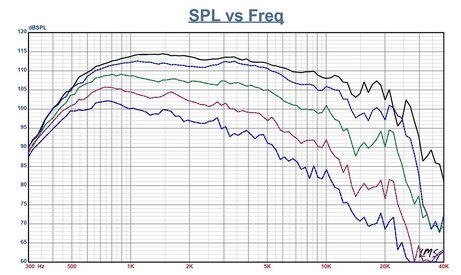
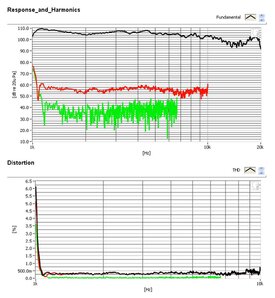
As you can see it has a good flat response with very good directivity control. Better than any other design so far. It’s distortion is silly low. More amazing, look carefully at the drive level. Pro drivers are tested at far higher levels than consumer drivers. This tweeter can play far louder than any consumer tweeter can dream of with no distortion. Obviously the really Hf stuff is a little messier than the ribbon, but again, this is completely waveguide dependent. Even the measuring distance matters here. It’s caused by reflections in the waveguide. Other designs don’t have this problem and it’s not as audible a problem as it looks.
How about a Beyma Air Motion:
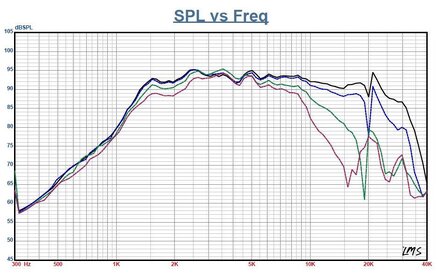
It’s not terrible, but i think the others look better. Most of its worst problems are near or above 20khz. It does beam quite a bit worse than the others.
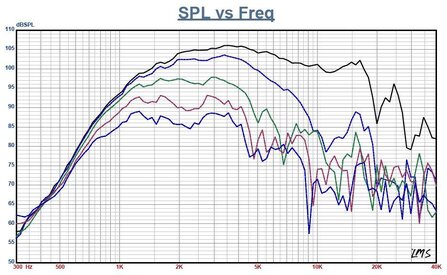
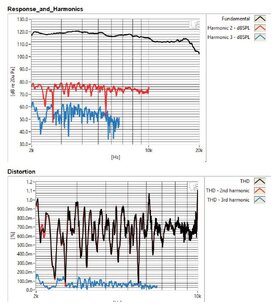
Here is the waveguide loaded version. For this one, I honestly don’t see the point. The response doesn’t look good. I don’t see a great advantage to this driver. It has a bad diffraction artifact at 15khz and doesn’t have the best directivity control. It is possible that with the right crossover it would achieve good results. It’s very likely that bad stuff at 15khz isn’t audible.
Distortion isn’t as bad as it looks. Look at the scale, it’s mostly under 1%. It’s also not better than other designs however.
So what else could be it’s advantage? Well a common view is that they are simply a more deft tweeter that store less energy and sound cleaner. Maybe? We saw the distortion was no better and response worse than other deistns (but again it’s totally a workable response). So let’s look at CSD:
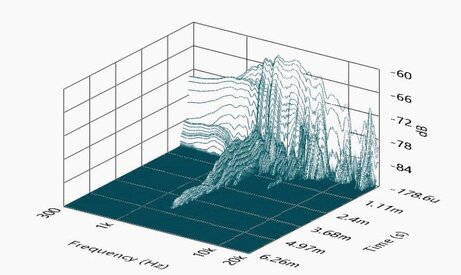
So that is pretty good actually. It stores very little energy. It’s on and off like a switch. Just a bit of stored energy at maybe like 3khz and very low in levels. So this could be a legit Claim.
Here is another Airmotion CSD:
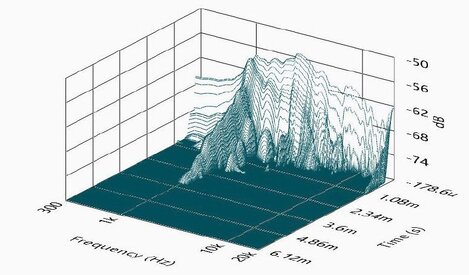
Again looks good. Not as good, but very good.
Here is a B&C compression driver, not as good but still good. Stores energy at 1-2khz. I believe that this may be somewhat waveguide dependent because it seems they are all over the place.
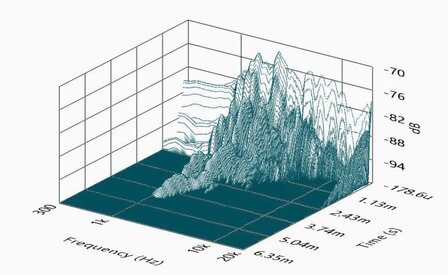
Here is that 18 sound which has a big 1.4” opening and 3” diaphragm. It also had a huge waveguide so I suspect this energy storage is characteristic of such a big system.
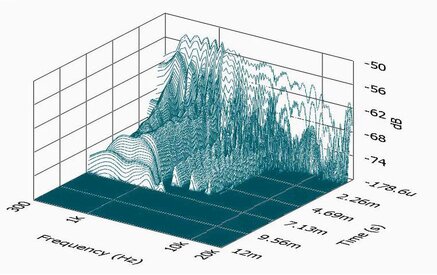
Pretty good all things considered but clearly sorting more energy than the others.
Here is that Satori Dome tweeter
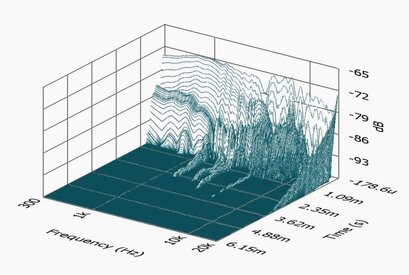
A bit more energy initially but absolutely no ringing. It’s good.
One last thing to make my point:
Look at this set of measurements.
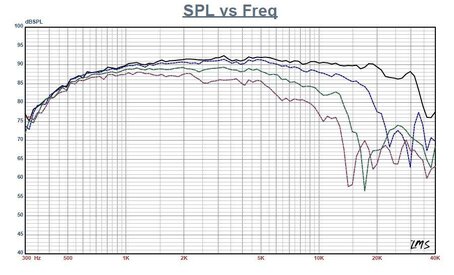
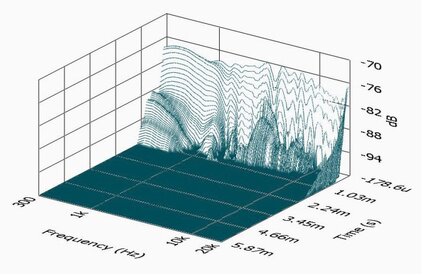
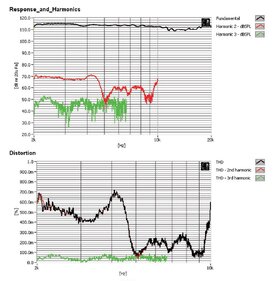
I think that looks really good. It does some things better and some things worse than other designs. As a whole I see nothing there to tell me it’s a lesser tweeter. That is a relatively cheap Wavecor silk dome tweeter. It even extends well past 20khz!
Now what was my own issue with the airmotion? Without naming names, I had some sent to me as samples to test. I won’t get into how or why, but needless to say, they ranged in price and quality but all came from the same Chinese manufacturer (who actually makes most of the Chinese built AMT’s for most companies).
One of them had poor QC and the pair I received measured differently. It had a buzz and distortion in one of the devices from bad riveting.
All displayed comb filtering but it seemed to dissipate with distance. I think the front plate causes it.
The large ones could be crossed low, below 2khz, but they were as big as a good waveguide that could cross a full octave lower. And they couldn’t extend smoothly past 10khz. They had a very irregular response. I figured it might work better as an upper midrange or lower treble driver. But then, what are making, 5-way speakers?
The medium sized ones were ok. Could cross around 2.5khz and had a workable response to my upper measurement limit of the time. They had high distortion if driven hard. Like they became non-linear quick. I found you would need to use high order crossovers or cross much higher to avoid the problem.
I ended up killing two of them in testing. I’ve never killed a tweeter in testing other than a ribbon once.
So I was left feeling like the AMT was fine but nothing special. That other drivers might offer advantages i prefer. I think because they are so hot I’m more sour on them given this experience. If it was treated like what I think it is, just another means to an end, I probably would be more forgiving.
Attachments
Last edited:







